
Monoctenia smerintharia, more commonly known as the dark leaf moth, is a moth of the family Geometridae first described by Rudolf Felder and Alois Friedrich Rogenhofer in 1875. It is found in Australia. The larvae feed on the leaves of gum trees.
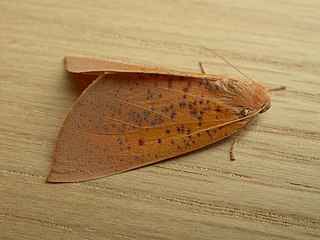
Plesanemma fucata, the lemon gum moth, is a moth of the family Geometridae. The species was first described by Rudolf Felder and Alois Friedrich Rogenhofer in 1875. It is found in the southern half of Australia.

Barea codrella, the barea moth, is a moth of the family Oecophoridae. It is found in Australia, more specifically Tasmania, New South Wales and Victoria and South Australia. It is also an adventive species in New Zealand.
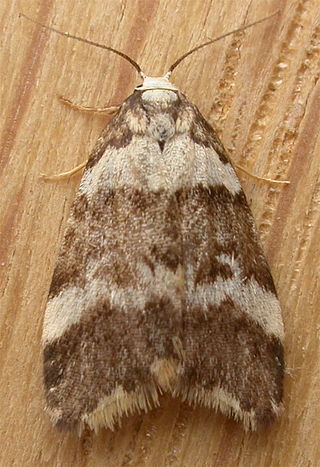
Halone sejuncta, the variable halone, is a moth of the subfamily Arctiinae first described by Rudolf Felder and Alois Friedrich Rogenhofer in 1875. It is found in Australia in Queensland, New South Wales, the Australian Capital Territory, Victoria, Tasmania and South Australia.
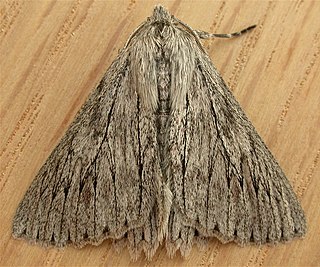
Cyneoterpna wilsoni, or Wilson's grey, is a moth of the family Geometridae first described by Rudolf Felder and Alois Friedrich Rogenhofer in 1875. It is found in the Australian states of Queensland, New South Wales, Victoria, South Australia and Tasmania.
Mabra is a genus of moths of the family Crambidae. It is placed in the tribe Portentomorphini of the subfamily Pyraustinae. The nine species of the genus are mainly distributed in tropical Asia, but M. metallescens and M. russoi are found in tropical Central and South America.

Eudesmeola is a monotypic moth genus of the family Erebidae erected by George Hampson in 1926. Its only species, Eudesmeola lawsoni, or Lawson's night moth, was first described by Felder and Rogenhofer in 1874. It is found in the dry inland areas of Australia.
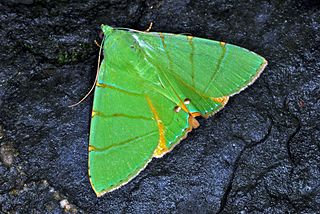
Eulepidotis is a genus of moths of the family Erebidae erected by Jacob Hübner in 1823.

Hagnagora is a genus of moths in the family Geometridae erected by Herbert Druce in 1885.
Prophantis octoguttalis is a species of moth of the family Crambidae. The species was described by Baron Cajetan von Felder, Rudolf Felder and Alois Friedrich Rogenhofer in 1875. It is found on the Maluku Islands in Indonesia.

Attonda adspersa is a moth of the family Erebidae first described by Rudolf Felder and Alois Friedrich Rogenhofer in 1874. It is known from the Democratic Republic of the Congo, Kenya, Madagascar, India, Sulawesi, Singapore, Borneo, Sumatra, Java, Bali, New Guinea and the Solomons.
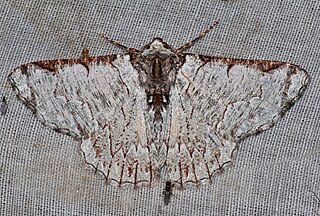
Lophophelma luteipes is a moth of the family Geometridae first described by Felder and Rogenhofer in 1875. It is found in China, the north-eastern Himalayas and Sundaland. The habitat consists of montane areas.

Epiphryne undosata, also known as the lacebark looper, is a moth of the family Geometridae. It is endemic to New Zealand and is found on both the North and South Islands. It inhabits native forest. The larvae feed on plant species in the genera Hoheria and Plagianthus. They pupate amongst dead leaves in a silk cocoon. The adult moths have been observed on the wing all year round but are most commonly seen from November until February. The adult moths are extremely variable in both their colour intensity and wing pattern.
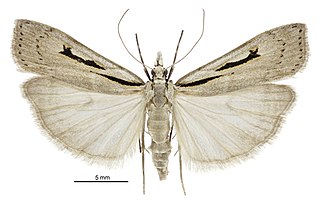
Scoparia rotuella is a species of moth in the family Crambidae. It was first described by Cajetan Felder, Rudolf Felder and Alois Friedrich Rogenhofer in 1875. It is endemic to New Zealand and, although considered localised, is found throughout the country. As at 2022 the life history of this species is largely unknown, but it has been hypothesised that this species may have two broods a year. Adults are on the wing all year round and are attracted to light.

Scoparia ustimacula, also known as the black-marked brown Scoparia moth, is a species of moth in the family Crambidae. It was described by Cajetan Felder, Rudolf Felder and Alois Friedrich Rogenhofer in 1875. It is endemic to New Zealand and can be found in the North, South and Stewart Islands. This species inhabits dense native forest at altitudes from sea level to approximately 1000 m. Although little is known of the life history of this species, larvae have been observed feeding on Hydrocotyle species. Adults are on the wing year round but are more commonly observed from September to March. Adults are nocturnal, are attracted to light and have been collected by beating scrub.
Thallarcha oblita, the hidden footman, is a moth in the subfamily Arctiinae. It was described by Rudolf Felder and Alois Friedrich Rogenhofer in 1875. It is found in Australia, where it has been recorded from the Australian Capital Territory, New South Wales and Victoria.
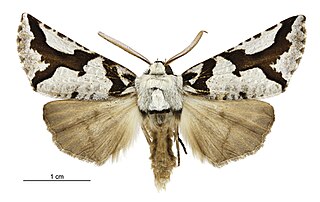
Declana egregia, commonly called the South Island lichen moth or zebra lichen moth, is a moth in the family Geometridae, endemic to New Zealand. This species was first described by entomologists Baron Cajetan von Felder and Alois Friedrich Rogenhofer in 1875 under the name Chlenias egregia.














